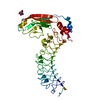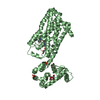Entry Database : PDB / ID : 4kt1Title Complex of R-spondin 1 with LGR4 extracellular domain Leucine-rich repeat-containing G-protein coupled receptor 4 R-spondin-1 Keywords / / / / / Function / homology Function Domain/homology Component
/ / / / / / / / / / / / / / / / / / / / / / / / / / / / / / / / / / / / / / / / / / / / / / / / / / / / / / / / / / / / / / / / / / / / / / / / / / / / / / / / / / / / / / / / Biological species Homo sapiens (human)Method / / / Resolution : 2.497 Å Authors Wang, X.Q. / Wang, D.L. Journal : Genes Dev. / Year : 2013Title : Structural basis for R-spondin recognition by LGR4/5/6 receptorsAuthors : Wang, D.L. / Huang, B. / Zhang, S. / Yu, X. / Wu, W. / Wang, X.Q. History Deposition May 19, 2013 Deposition site / Processing site Revision 1.0 Jun 19, 2013 Provider / Type Revision 1.1 Aug 14, 2013 Group Revision 2.0 Jul 29, 2020 Group Advisory / Atomic model ... Advisory / Atomic model / Data collection / Database references / Derived calculations / Structure summary Category atom_site / chem_comp ... atom_site / chem_comp / entity / pdbx_branch_scheme / pdbx_chem_comp_identifier / pdbx_entity_branch / pdbx_entity_branch_descriptor / pdbx_entity_branch_link / pdbx_entity_branch_list / pdbx_entity_nonpoly / pdbx_nonpoly_scheme / pdbx_struct_assembly_gen / pdbx_validate_close_contact / struct_asym / struct_conn / struct_ref_seq_dif / struct_site / struct_site_gen Item _atom_site.auth_asym_id / _atom_site.auth_seq_id ... _atom_site.auth_asym_id / _atom_site.auth_seq_id / _atom_site.label_asym_id / _atom_site.label_entity_id / _chem_comp.name / _chem_comp.type / _pdbx_entity_nonpoly.entity_id / _pdbx_entity_nonpoly.name / _pdbx_struct_assembly_gen.asym_id_list / _pdbx_validate_close_contact.auth_asym_id_2 / _pdbx_validate_close_contact.auth_seq_id_2 / _struct_conn.pdbx_dist_value / _struct_conn.pdbx_leaving_atom_flag / _struct_conn.pdbx_role / _struct_conn.ptnr1_auth_asym_id / _struct_conn.ptnr1_auth_comp_id / _struct_conn.ptnr1_auth_seq_id / _struct_conn.ptnr1_label_asym_id / _struct_conn.ptnr1_label_atom_id / _struct_conn.ptnr1_label_comp_id / _struct_conn.ptnr1_label_seq_id / _struct_conn.ptnr2_auth_asym_id / _struct_conn.ptnr2_auth_seq_id / _struct_conn.ptnr2_label_asym_id / _struct_ref_seq_dif.details Description / Provider / Type Revision 2.1 Nov 8, 2023 Group Data collection / Database references ... Data collection / Database references / Refinement description / Structure summary Category chem_comp / chem_comp_atom ... chem_comp / chem_comp_atom / chem_comp_bond / database_2 / pdbx_initial_refinement_model Item / _database_2.pdbx_DOI / _database_2.pdbx_database_accession
Show all Show less
 Open data
Open data Basic information
Basic information Components
Components Keywords
Keywords Wnt signaling / HORMONE RECEPTOR-CELL ADHESION complex
Wnt signaling / HORMONE RECEPTOR-CELL ADHESION complex Function and homology information
Function and homology information regulation of receptor internalization / negative regulation of toll-like receptor signaling pathway / positive regulation of branching involved in ureteric bud morphogenesis ...cell differentiation involved in metanephros development / metanephric glomerulus development / metanephric nephron tubule morphogenesis / : / epithelial cell proliferation involved in renal tubule morphogenesis / protein-hormone receptor activity / intestinal stem cell homeostasis /
regulation of receptor internalization / negative regulation of toll-like receptor signaling pathway / positive regulation of branching involved in ureteric bud morphogenesis ...cell differentiation involved in metanephros development / metanephric glomerulus development / metanephric nephron tubule morphogenesis / : / epithelial cell proliferation involved in renal tubule morphogenesis / protein-hormone receptor activity / intestinal stem cell homeostasis /  regulation of receptor internalization / negative regulation of toll-like receptor signaling pathway / positive regulation of branching involved in ureteric bud morphogenesis / male genitalia development /
regulation of receptor internalization / negative regulation of toll-like receptor signaling pathway / positive regulation of branching involved in ureteric bud morphogenesis / male genitalia development /  bone remodeling / G protein-coupled peptide receptor activity / digestive tract development / negative regulation of cold-induced thermogenesis / negative regulation of cytokine production /
bone remodeling / G protein-coupled peptide receptor activity / digestive tract development / negative regulation of cold-induced thermogenesis / negative regulation of cytokine production /  bone mineralization / positive regulation of Wnt signaling pathway / hair follicle development / Regulation of FZD by ubiquitination / G protein-coupled receptor binding / G protein-coupled receptor activity / circadian regulation of gene expression / adenylate cyclase-activating G protein-coupled receptor signaling pathway /
bone mineralization / positive regulation of Wnt signaling pathway / hair follicle development / Regulation of FZD by ubiquitination / G protein-coupled receptor binding / G protein-coupled receptor activity / circadian regulation of gene expression / adenylate cyclase-activating G protein-coupled receptor signaling pathway /  Wnt signaling pathway / osteoblast differentiation / positive regulation of canonical Wnt signaling pathway / transmembrane signaling receptor activity /
Wnt signaling pathway / osteoblast differentiation / positive regulation of canonical Wnt signaling pathway / transmembrane signaling receptor activity /  heparin binding /
heparin binding /  spermatogenesis / positive regulation of protein phosphorylation /
spermatogenesis / positive regulation of protein phosphorylation /  signaling receptor binding /
signaling receptor binding /  innate immune response / negative regulation of DNA-templated transcription / positive regulation of DNA-templated transcription / extracellular region /
innate immune response / negative regulation of DNA-templated transcription / positive regulation of DNA-templated transcription / extracellular region /  nucleus /
nucleus /  plasma membrane
plasma membrane
 Homo sapiens (human)
Homo sapiens (human) X-RAY DIFFRACTION /
X-RAY DIFFRACTION /  SYNCHROTRON /
SYNCHROTRON /  MOLECULAR REPLACEMENT / Resolution: 2.497 Å
MOLECULAR REPLACEMENT / Resolution: 2.497 Å  Authors
Authors Citation
Citation Journal: Genes Dev. / Year: 2013
Journal: Genes Dev. / Year: 2013 Structure visualization
Structure visualization Molmil
Molmil Jmol/JSmol
Jmol/JSmol Downloads & links
Downloads & links Download
Download 4kt1.cif.gz
4kt1.cif.gz PDBx/mmCIF format
PDBx/mmCIF format pdb4kt1.ent.gz
pdb4kt1.ent.gz PDB format
PDB format 4kt1.json.gz
4kt1.json.gz PDBx/mmJSON format
PDBx/mmJSON format Other downloads
Other downloads https://data.pdbj.org/pub/pdb/validation_reports/kt/4kt1
https://data.pdbj.org/pub/pdb/validation_reports/kt/4kt1 ftp://data.pdbj.org/pub/pdb/validation_reports/kt/4kt1
ftp://data.pdbj.org/pub/pdb/validation_reports/kt/4kt1
 Links
Links Assembly
Assembly
 Components
Components
 Homo sapiens (human) / Gene: LGR4 / Plasmid: pFastBac / Production host:
Homo sapiens (human) / Gene: LGR4 / Plasmid: pFastBac / Production host: 
 Spodoptera frugiperda (fall armyworm) / References: UniProt: Q9BXB1
Spodoptera frugiperda (fall armyworm) / References: UniProt: Q9BXB1
 Homo sapiens (human) / Gene: RSPO1 / Plasmid: pFastBac / Production host:
Homo sapiens (human) / Gene: RSPO1 / Plasmid: pFastBac / Production host: 
 Spodoptera frugiperda (fall armyworm) / References: UniProt: Q2MKA7
Spodoptera frugiperda (fall armyworm) / References: UniProt: Q2MKA7 / Mass: 424.401 Da / Num. of mol.: 1
/ Mass: 424.401 Da / Num. of mol.: 1 N-Acetylglucosamine
N-Acetylglucosamine Water
Water X-RAY DIFFRACTION / Number of used crystals: 1
X-RAY DIFFRACTION / Number of used crystals: 1  Sample preparation
Sample preparation
 SYNCHROTRON / Site:
SYNCHROTRON / Site:  SSRF
SSRF  / Beamline: BL17U / Wavelength: 0.97 Å
/ Beamline: BL17U / Wavelength: 0.97 Å : 0.97 Å / Relative weight: 1
: 0.97 Å / Relative weight: 1  Processing
Processing :
:  MOLECULAR REPLACEMENT
MOLECULAR REPLACEMENT Movie
Movie Controller
Controller













 PDBj
PDBj




















